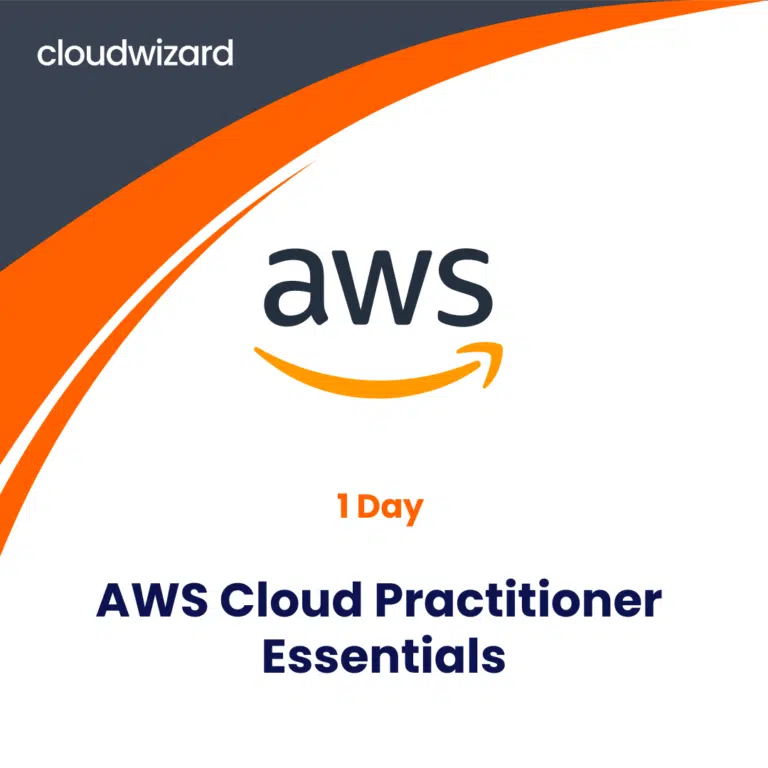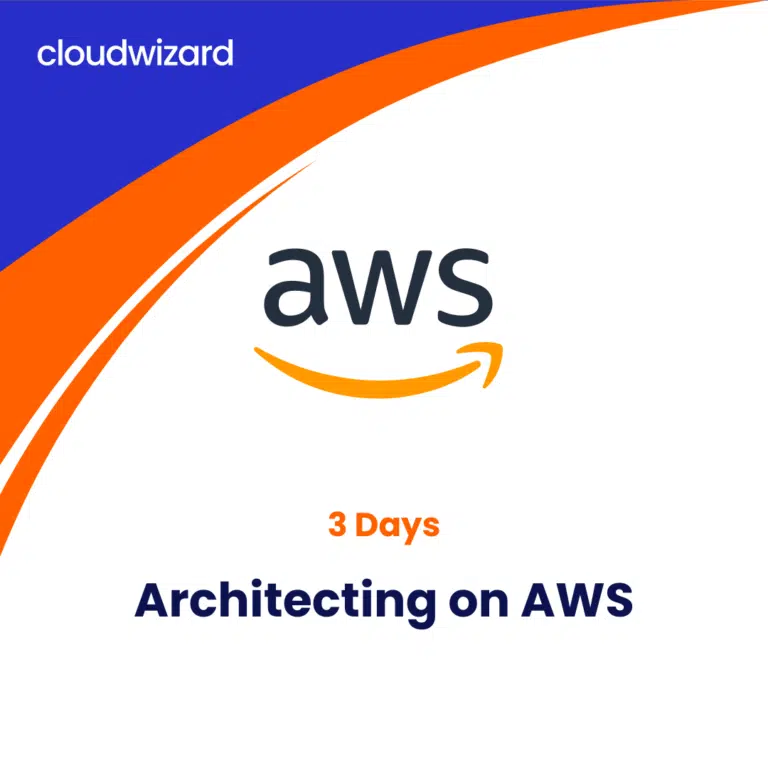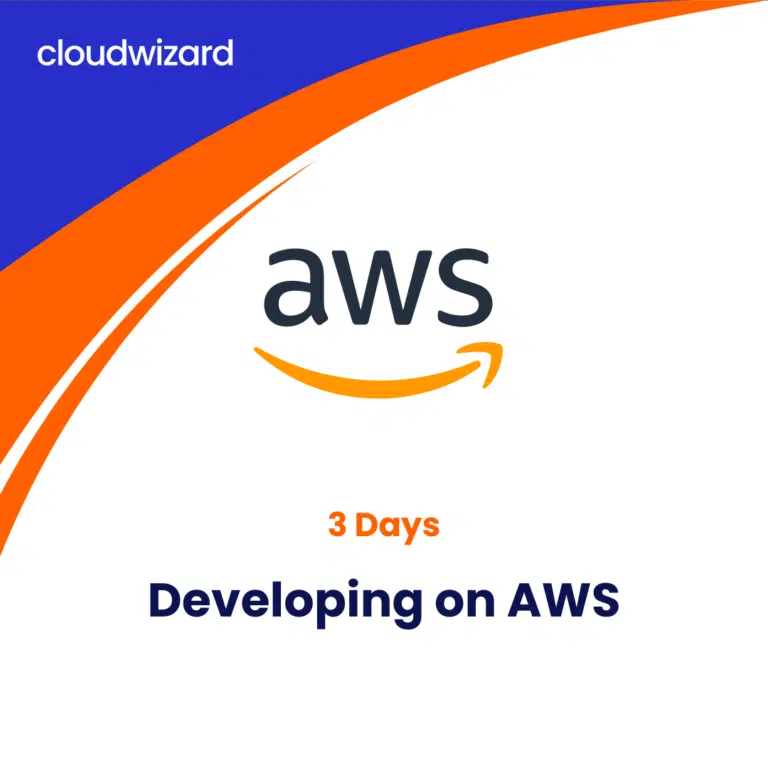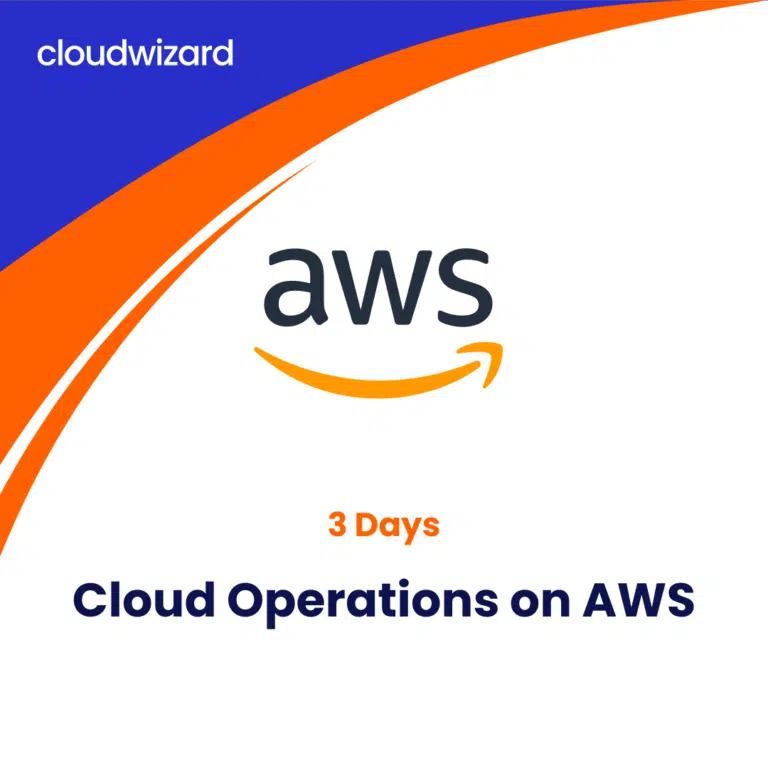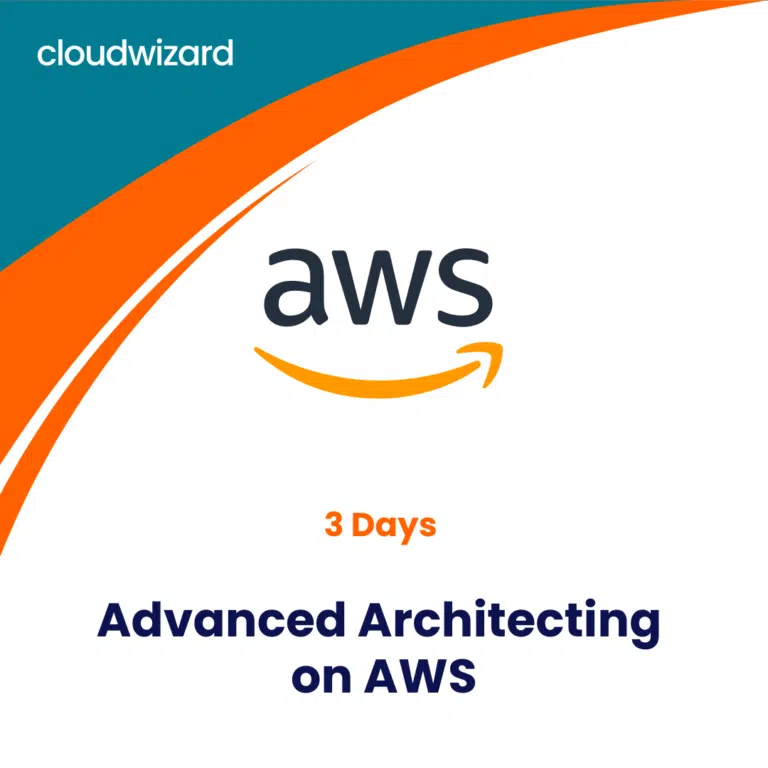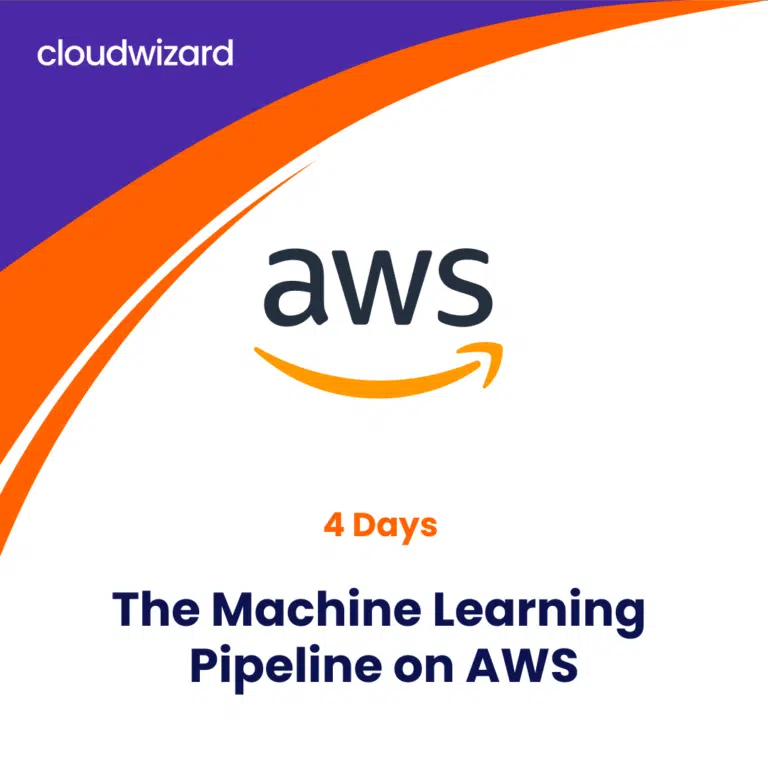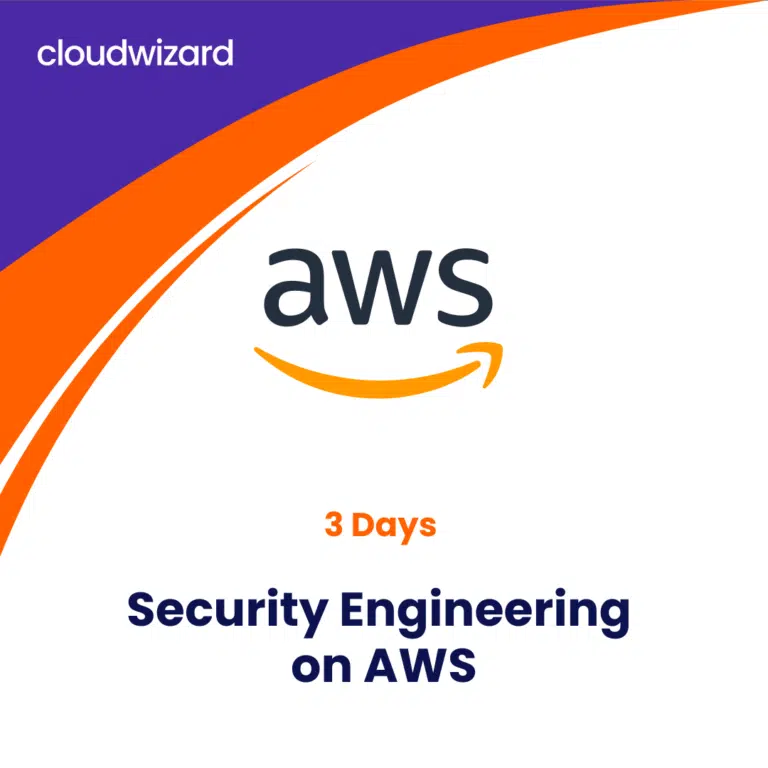Developing on AWS
This course is for developers who want to learn to interact with AWS services to build web applications. The learner will go through a high-level architectural discussion on how to select resources and use the AWS Software Development Kits (AWS SDKs) and Command line interface (AWS CLI) to build and deploy cloud applications. The course also teaches how to use the AWS Core Services, configure authentications, deploy applications to the cloud and debug them to resolve any potential issues.
This course is intended for experienced software developers, solution architects and IT employees who want to develop their skills in using the AWS Cloud. The learners will also be able to prepare for the AWS Certified Developer Associate certification by participating in this program.
The course delivery is done by an expert AWS instructor with theory, real-life scenarios and hands-on labs
3 Days / 24 Hours
Live Class
Certificate on completion
You will learn about the following
- Using AWS Software Development Kits (AWS SDKs), the Command Line Interface (AWS CLI), and IDEs, create a straightforward end-to-end cloud application.
- Configure AWS Identity and Access Management (IAM) permissions to support a development environment.
- To use AWS services, use a variety of programming paradigms in your apps.
- Create, read, update, and delete (CRUD) activities may be carried out on Amazon Simple Storage Service (Amazon S3) and Amazon DynamoDB resources using AWS SDKs.
- Create AWS Lambda functions for your web apps by integrating them with other services.
- Understand the benefits of microservices architectures and serverless apps to design.
- Create components for API Gateway and combine them with other AWS services.
- What mechanisms does Amazon Cognito utilize for regulating user access to AWS resources?
- Use Cognito to create a web application that grants and manages user access. Utilize the DevOps technique to lessen the risks connected with the release of conventional applications and find AWS
- services that support adopting DevOps principles.
- To deploy an application, use AWS Serverless Application Model (AWS SAM).
- Utilize Amazon X-Ray to track the development of your application.
What experience you need
- AWS Technical Essentials OR AWS Cloud Practitioner Essentials
- Working knowledge of AWS core services
- Programming experience in any one of the following languages:
- Python | .NET | Java
Who should take this course
- A Software Developer
- An IT Architect
- Individuals looking for the Developing on AWS Classroom Training
- Learners looking to attempt the AWS Certified Developer Associate Exam
Module 1: Course Overview
- Logistics
- Student resources
- Agenda
- Introductions
Module 2: Building a Web Application on AWS
- Discuss the architecture of the application you are going to build during this course
- Explore the AWS services needed to build your web application
- Discover how to store, manage, and host your web application
Module 3: Getting started with Development on AWS
- Describe how to access AWS services programmatically
- List some programmatic patterns and how they provide efficiencies within AWS SDKs and AWS CLI
- Explain the value of AWS Cloud9
Module 4: Getting Started with Permissions
- Review AWS Identity and Access Management (IAM) features and components permissions to support a development environment
- Demonstrate how to test AWS IAM permissions
- Configure your IDEs and SDKs to support a development environment
- Demonstrate accessing AWS services using SDKs and AWS Cloud9
Lab 1: Configure the Developer Environment
- Connect to a developer environment
- Verify that the IDE and the AWS CLI are installed and configured to use the application profile
- Verify that the necessary permissions have been granted to run AWS CLI commands
- Assign an AWS IAM policy to a role to delete an Amazon S3 bucket
Module 5: Getting started with Storage
- Describe the basic concepts of Amazon S3
- List the options for securing data using Amazon S3
- Define SDK dependencies for your code
- Explain how to connect to the Amazon S3 service
- Describe request and response objects
Module 6: Processing your Storage Operations
- Perform key bucket and object operations
- Explain how to handle multiple and large objects
- Create and configure an Amazon S3 bucket to host a static website
- Grant temporary access to your objects
- Demonstrate performing Amazon S3 operations using SDKs
Lab 2: Develop Solutions using Amazon S3
- Interact with Amazon S3 programmatically using AWS SDKs and the AWS CLI
- Create a bucket using waiters and verify service exceptions codes
- Build the needed requests to upload an Amazon S3 object with metadata attached
- Build requests to download an object from the bucket, process data, and upload the object back to the bucket
- Configure a bucket to host the website and sync the source files using the AWS CLI
- Add IAM bucket policies to access the S3 website.
Module 7: Getting started with Databases
- Describe the key components of DynamoDB
- Explain how to connect to DynamoDB
- Describe how to build a request object
- Explain how to read a response object
- List the most common troubleshooting exceptions
Module 8: Processing your Database Operations
- Develop programs to interact with DynamoDB using AWS SDKs
- Perform CRUD operations to access tables, indexes, and data
- Describe developer best practices when accessing DynamoDB
- Review caching options for DynamoDB to improve performance
- Perform DynamoDB operations using SDK
Lab 3: Develop Solutions using Amazon DynamoDB
- Interact with Amazon DynamoDB programmatically using low-level, document, and high-level APIs in your programs
- Retrieve items from a table using key attributes, filters, expressions, and paginations
- Load a table by reading JSON objects from a file
- Search items from a table based on key attributes, filters, expressions, and paginations
- Update items by adding new attributes and changing data conditionally
- Access DynamoDB data using PartiQL and object-persistence models where applicable
Module 9: Processing your Application Logic
- Develop a Lambda function using SDKs
- Configure triggers and permissions for Lambda functions
- Test, deploy, and monitor Lambda functions
Lab 4: Develop Solutions using AWS Lambda Functions
- Create AWS Lambda functions and interact programmatically using AWS SDKs and AWS CLI
- Configure AWS Lambda functions to use the environment variables and to integrate with other services
- Generate Amazon S3 pre-signed URLs using AWS SDKs and verify the access to bucket objects
- Deploy the AWS Lambda functions with .zip file archives through your IDE and test as needed
- Invoke AWS Lambda functions using the AWS Console and AWS CLI
Module 10: Managing the APIS
- Describe the key components of API Gateway
- Develop API Gateway resources to integrate with AWS services
- Configure API request and response calls for your application endpoints
- Test API resources and deploy your application API endpoint
- Demonstrate creating API Gateway resources to interact with your application APIs
Lab 5: Develop Solutions using Amazon API Gateway
- Create RESTful API Gateway resources and configure CORS for your application
- Integrate API methods with AWS Lambda functions to process application data
- Configure mapping templates to transform the pass-through data during method integration
- Create a request model for API methods to ensure that the pass-through data format complies with application rules
- Deploy the API Gateway to a stage and validate the results using the API endpoint
Module 11: Building a Modern Application
- Describe the challenges with traditional architectures
- Describe the microservice architecture and benefits
- Explain various approaches for designing microservice applications
- Explain steps involved in decoupling monolithic applications
- Demonstrate the orchestration of Lambda Functions using AWS Step Functions
Module 12: Granting Access to your Applications Users
- Analyze the evolution of security protocols
- Explore the authentication process using Amazon Cognito
- Manage user access and authorize serverless APIs
- Observe best practices for implementing Amazon Cognito
- Demonstrate the integration of Amazon Cognito and review JWT tokens
Lab 6: Capstone – Complete the Application Build
- Create a Userpool and an Application Client for your web application using
- Add new users and confirm their ability to sign-in using the Amazon Cognito CLI
- Configure API Gateway methods to use Amazon Cognito as an authorizer
- Verify JWT authentication tokens are generated during API Gateway calls
- Develop API Gateway resources rapidly using a Swagger importing strategy
- Set up your web application frontend to use Amazon Cognito and API Gateway configurations and verify the entire application functionality
Module 13: Deploying your Application
- Identify risks associated with traditional software development practices
- Understand DevOps methodology
- Configure an AWS SAM template to deploy a serverless application
- Describe various application deployment strategies
- Demonstrate deploying a serverless application using AWS SAM
Module 14: Observing your Application
- Differentiate between monitoring and observability
- Evaluate why observability is necessary in modern development and key components
- Understand CloudWatch’s part in configuring the observability
- Demonstrate using CloudWatch Application Insights to monitor applications
- Demonstrate using X-Ray to debug your applications
Lab 7: Observe the Applications using AWS X-Ray
- Instrument your application code to use AWS X-Ray capabilities
- Enable your application deployment package to generate logs
- Understand the key components of an AWS SAM template and deploy your application
- Create AWS X-Ray service maps to observe end-to-end processing behavior of your application
- Analyze and debug application issues using AWS X-Ray traces and annotations
Module 15: Course Wrap-up
- Course overview
- AWS training courses
- Certifications
- Course feedback
Talk to a Learning Advisor
Popular AWS Courses
FAQs
To enroll in this course, choose the starting date and make an online payment. Once your payment is confirmed, our team will reach out to you.
You may reach out at the contact number listed on our official website or write us at info@cloudwizardconsulting.com
Wire Transfer, Credit Card, Debit Card, UPI & Purchase Order.
There is no minimum number of candidates required, we are happy to train 1 to 1 . With regards to the maximum number, we can accomodate 30 learners in one batch.
- Training Delivered by an Amazon Authorized Instructor.
- AWS Content E-Kit
- Hands-on-labs for 30 days
- Class attendance certificate
You will get the access to course content & lab on first day of your training session.
The course Completion Certificate will be issued to your email id within 2 weeks of completing your course.
A one-day course could be delivered over two half day sessions (4 hours a day), or a three-day course could be delivered over five days (4 hours a day)
MOBILE LAYOUT
Developing on AWS
3 Days / 24 Hours
Live Class
Certificate on completion
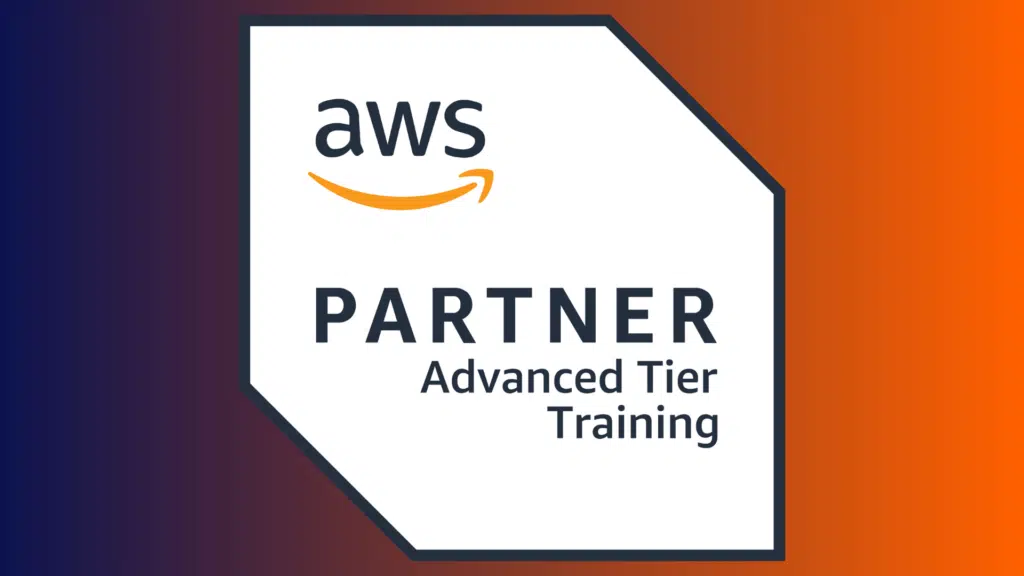
Objectives
In this Developing on AWS course, you will learn the following things:
- Using AWS Software Development Kits (AWS SDKs), the Command Line Interface (AWS CLI), and IDEs, create a straightforward end-to-end cloud application.
- Configure AWS Identity and Access Management (IAM) permissions to support a development environment.
- To use AWS services, use a variety of programming paradigms in your apps.
- Create, read, update, and delete (CRUD) activities may be carried out on Amazon Simple Storage Service (Amazon S3) and Amazon DynamoDB resources using AWS SDKs.
- Create AWS Lambda functions for your web apps by integrating them with other services.
- Understand the benefits of microservices architectures and serverless apps to design.
- Create components for API Gateway and combine them with other AWS services.
- What mechanisms does Amazon Cognito utilize for regulating user access to AWS resources?
- Use Cognito to create a web application that grants and manages user access. Utilize the DevOps technique to lessen the risks connected with the release of conventional applications and find AWS
- services that support adopting DevOps principles.
- To deploy an application, use AWS Serverless Application Model (AWS SAM).
- Utilize Amazon X-Ray to track the development of your application.
Prerequisites
We recommend that attendees of this course have:
- AWS Technical Essentials OR AWS Cloud Practitioner Essentials
- Working knowledge of AWS core services
- Programming experience in any one of the following languages:
- Python | .NET | Java
Intendend Audience
This Developing on AWS course is for you – if you are either of the following:
- A Software Developer
- An IT Architect
- Individuals looking for the Developing on AWS Classroom Training
- Learners looking to attempt the AWS Certified Developer Associate Exam
Module Breakdown
Module 1: Course Overview
- Logistics
- Student resources
- Agenda
- Introductions
Module 2: Building a Web Application on AWS
- Discuss the architecture of the application you are going to build during this course
- Explore the AWS services needed to build your web application
- Discover how to store, manage, and host your web application
Module 3: Getting started with Development on AWS
- Describe how to access AWS services programmatically
- List some programmatic patterns and how they provide efficiencies within AWS SDKs and AWS CLI
- Explain the value of AWS Cloud9
Module 4: Getting Started with Permissions
- Review AWS Identity and Access Management (IAM) features and components permissions to support a development environment
- Demonstrate how to test AWS IAM permissions
- Configure your IDEs and SDKs to support a development environment
- Demonstrate accessing AWS services using SDKs and AWS Cloud9
Lab 1: Configure the Developer Environment
- Connect to a developer environment
- Verify that the IDE and the AWS CLI are installed and configured to use the application profile
- Verify that the necessary permissions have been granted to run AWS CLI commands
- Assign an AWS IAM policy to a role to delete an Amazon S3 bucket
Module 5: Getting started with Storage
- Describe the basic concepts of Amazon S3
- List the options for securing data using Amazon S3
- Define SDK dependencies for your code
- Explain how to connect to the Amazon S3 service
- Describe request and response objects
Module 6: Processing your Storage Operations
- Perform key bucket and object operations
- Explain how to handle multiple and large objects
- Create and configure an Amazon S3 bucket to host a static website
- Grant temporary access to your objects
- Demonstrate performing Amazon S3 operations using SDKs
Lab 2: Develop Solutions using Amazon S3
- Interact with Amazon S3 programmatically using AWS SDKs and the AWS CLI
- Create a bucket using waiters and verify service exceptions codes
- Build the needed requests to upload an Amazon S3 object with metadata attached
- Build requests to download an object from the bucket, process data, and upload the object back to the bucket
- Configure a bucket to host the website and sync the source files using the AWS CLI
- Add IAM bucket policies to access the S3 website.
Module 7: Getting started with Databases
- Describe the key components of DynamoDB
- Explain how to connect to DynamoDB
- Describe how to build a request object
- Explain how to read a response object
- List the most common troubleshooting exceptions
Module 8: Processing your Database Operations
- Develop programs to interact with DynamoDB using AWS SDKs
- Perform CRUD operations to access tables, indexes, and data
- Describe developer best practices when accessing DynamoDB
- Review caching options for DynamoDB to improve performance
- Perform DynamoDB operations using SDK
Lab 3: Develop Solutions using Amazon DynamoDB
- Interact with Amazon DynamoDB programmatically using low-level, document, and high-level APIs in your programs
- Retrieve items from a table using key attributes, filters, expressions, and paginations
- Load a table by reading JSON objects from a file
- Search items from a table based on key attributes, filters, expressions, and paginations
- Update items by adding new attributes and changing data conditionally
- Access DynamoDB data using PartiQL and object-persistence models where applicable
Module 9: Processing your Application Logic
- Develop a Lambda function using SDKs
- Configure triggers and permissions for Lambda functions
- Test, deploy, and monitor Lambda functions
Lab 4: Develop Solutions using AWS Lambda Functions
- Create AWS Lambda functions and interact programmatically using AWS SDKs and AWS CLI
- Configure AWS Lambda functions to use the environment variables and to integrate with other services
- Generate Amazon S3 pre-signed URLs using AWS SDKs and verify the access to bucket objects
- Deploy the AWS Lambda functions with .zip file archives through your IDE and test as needed
- Invoke AWS Lambda functions using the AWS Console and AWS CLI
Module 10: Managing the APIS
- Describe the key components of API Gateway
- Develop API Gateway resources to integrate with AWS services
- Configure API request and response calls for your application endpoints
- Test API resources and deploy your application API endpoint
- Demonstrate creating API Gateway resources to interact with your application APIs
Lab 5: Develop Solutions using Amazon API Gateway
- Create RESTful API Gateway resources and configure CORS for your application
- Integrate API methods with AWS Lambda functions to process application data
- Configure mapping templates to transform the pass-through data during method integration
- Create a request model for API methods to ensure that the pass-through data format complies with application rules
- Deploy the API Gateway to a stage and validate the results using the API endpoint
Module 11: Building a Modern Application
- Describe the challenges with traditional architectures
- Describe the microservice architecture and benefits
- Explain various approaches for designing microservice applications
- Explain steps involved in decoupling monolithic applications
- Demonstrate the orchestration of Lambda Functions using AWS Step Functions
Module 12: Granting Access to your Applications Users
- Analyze the evolution of security protocols
- Explore the authentication process using Amazon Cognito
- Manage user access and authorize serverless APIs
- Observe best practices for implementing Amazon Cognito
- Demonstrate the integration of Amazon Cognito and review JWT tokens
Lab 6: Capstone – Complete the Application Build
- Create a Userpool and an Application Client for your web application using
- Add new users and confirm their ability to sign-in using the Amazon Cognito CLI
- Configure API Gateway methods to use Amazon Cognito as an authorizer
- Verify JWT authentication tokens are generated during API Gateway calls
- Develop API Gateway resources rapidly using a Swagger importing strategy
- Set up your web application frontend to use Amazon Cognito and API Gateway configurations and verify the entire application functionality
Module 13: Deploying your Application
- Identify risks associated with traditional software development practices
- Understand DevOps methodology
- Configure an AWS SAM template to deploy a serverless application
- Describe various application deployment strategies
- Demonstrate deploying a serverless application using AWS SAM
Module 14: Observing your Application
- Differentiate between monitoring and observability
- Evaluate why observability is necessary in modern development and key components
- Understand CloudWatch’s part in configuring the observability
- Demonstrate using CloudWatch Application Insights to monitor applications
- Demonstrate using X-Ray to debug your applications
Lab 7: Observe the Applications using AWS X-Ray
- Instrument your application code to use AWS X-Ray capabilities
- Enable your application deployment package to generate logs
- Understand the key components of an AWS SAM template and deploy your application
- Create AWS X-Ray service maps to observe end-to-end processing behavior of your application
- Analyze and debug application issues using AWS X-Ray traces and annotations
Module 15: Course Wrap-up
- Course overview
- AWS training courses
- Certifications
- Course feedback
Talk to a Learning Advisor
Tablet View
Popular AWS Courses
FAQs
To enroll in this course, choose the starting date and make an online payment. Once your payment is confirmed, our team will reach out to you.
You may reach out at the contact number listed on our official website or write us at info@cloudwizardconsulting.com
Wire Transfer, Credit Card, Debit Card, UPI & Purchase Order.
There is no minimum number of candidates required, we are happy to train 1 to 1 . With regards to the maximum number, we can accomodate 30 learners in one batch.
- Training Delivered by an Amazon Authorized Instructor.
- AWS Content E-Kit
- Hands-on-labs for 30 days
- Class attendance certificate
You will get the access to course content & lab on first day of your training session.
The course Completion Certificate will be issued to your email id within 2 weeks of completing your course.
A one-day course could be delivered over two half day sessions (4 hours a day), or a three-day course could be delivered over five days (4 hours a day)
Developing on AWS
This course is for developers who want to learn to interact with AWS services to build web applications. The learner will go through a high-level architectural discussion on how to select resources and use the AWS Software Development Kits (AWS SDKs) and Command line interface (AWS CLI) to build and deploy cloud applications. The course also teaches how to use the AWS Core Services, configure authentications, deploy applications to the cloud and debug them to resolve any potential issues.
This course is intended for experienced software developers, solution architects and IT employees who want to develop their skills in using the AWS Cloud. The learners will also be able to prepare for the AWS Certified Developer Associate certification by participating in this program.
The course delivery is done by an expert AWS instructor with theory, real-life scenarios and hands-on labs
3 Days / 24 Hours
Live Class
Certificate on completion
Objectives
In this Developing on AWS course, you will learn the following things:
- Using AWS Software Development Kits (AWS SDKs), the Command Line Interface (AWS CLI), and IDEs, create a straightforward end-to-end cloud application.
- Configure AWS Identity and Access Management (IAM) permissions to support a development environment.
- To use AWS services, use a variety of programming paradigms in your apps.
- Create, read, update, and delete (CRUD) activities may be carried out on Amazon Simple Storage Service (Amazon S3) and Amazon DynamoDB resources using AWS SDKs.
- Create AWS Lambda functions for your web apps by integrating them with other services.
- Understand the benefits of microservices architectures and serverless apps to design.
- Create components for API Gateway and combine them with other AWS services.
- What mechanisms does Amazon Cognito utilize for regulating user access to AWS resources?
- Use Cognito to create a web application that grants and manages user access. Utilize the DevOps technique to lessen the risks connected with the release of conventional applications and find AWS
- services that support adopting DevOps principles.
- To deploy an application, use AWS Serverless Application Model (AWS SAM).
- Utilize Amazon X-Ray to track the development of your application.
Prerequisites
We recommend that attendees of this course have:
- AWS Technical Essentials OR AWS Cloud Practitioner Essentials
- Working knowledge of AWS core services
- Programming experience in any one of the following languages:
- Python | .NET | Java
Intended Audience
This Developing on AWS course is for you – if you are either of the following:
- A Software Developer
- An IT Architect
- Individuals looking for the Developing on AWS Classroom Training
- Learners looking to attempt the AWS Certified Developer Associate Exam
Module 1: Course Overview
- Logistics
- Student resources
- Agenda
- Introductions
Module 2: Building a Web Application on AWS
- Discuss the architecture of the application you are going to build during this course
- Explore the AWS services needed to build your web application
- Discover how to store, manage, and host your web application
Module 3: Getting started with Development on AWS
- Describe how to access AWS services programmatically
- List some programmatic patterns and how they provide efficiencies within AWS SDKs and AWS CLI
- Explain the value of AWS Cloud9
Module 4: Getting Started with Permissions
- Review AWS Identity and Access Management (IAM) features and components permissions to support a development environment
- Demonstrate how to test AWS IAM permissions
- Configure your IDEs and SDKs to support a development environment
- Demonstrate accessing AWS services using SDKs and AWS Cloud9
Lab 1: Configure the Developer Environment
- Connect to a developer environment
- Verify that the IDE and the AWS CLI are installed and configured to use the application profile
- Verify that the necessary permissions have been granted to run AWS CLI commands
- Assign an AWS IAM policy to a role to delete an Amazon S3 bucket
Module 5: Getting started with Storage
- Describe the basic concepts of Amazon S3
- List the options for securing data using Amazon S3
- Define SDK dependencies for your code
- Explain how to connect to the Amazon S3 service
- Describe request and response objects
Module 6: Processing your Storage Operations
- Perform key bucket and object operations
- Explain how to handle multiple and large objects
- Create and configure an Amazon S3 bucket to host a static website
- Grant temporary access to your objects
- Demonstrate performing Amazon S3 operations using SDKs
Lab 2: Develop Solutions using Amazon S3
- Interact with Amazon S3 programmatically using AWS SDKs and the AWS CLI
- Create a bucket using waiters and verify service exceptions codes
- Build the needed requests to upload an Amazon S3 object with metadata attached
- Build requests to download an object from the bucket, process data, and upload the object back to the bucket
- Configure a bucket to host the website and sync the source files using the AWS CLI
- Add IAM bucket policies to access the S3 website.
Module 7: Getting started with Databases
- Describe the key components of DynamoDB
- Explain how to connect to DynamoDB
- Describe how to build a request object
- Explain how to read a response object
- List the most common troubleshooting exceptions
Module 8: Processing your Database Operations
- Develop programs to interact with DynamoDB using AWS SDKs
- Perform CRUD operations to access tables, indexes, and data
- Describe developer best practices when accessing DynamoDB
- Review caching options for DynamoDB to improve performance
- Perform DynamoDB operations using SDK
Lab 3: Develop Solutions using Amazon DynamoDB
- Interact with Amazon DynamoDB programmatically using low-level, document, and high-level APIs in your programs
- Retrieve items from a table using key attributes, filters, expressions, and paginations
- Load a table by reading JSON objects from a file
- Search items from a table based on key attributes, filters, expressions, and paginations
- Update items by adding new attributes and changing data conditionally
- Access DynamoDB data using PartiQL and object-persistence models where applicable
Module 9: Processing your Application Logic
- Develop a Lambda function using SDKs
- Configure triggers and permissions for Lambda functions
- Test, deploy, and monitor Lambda functions
Lab 4: Develop Solutions using AWS Lambda Functions
- Create AWS Lambda functions and interact programmatically using AWS SDKs and AWS CLI
- Configure AWS Lambda functions to use the environment variables and to integrate with other services
- Generate Amazon S3 pre-signed URLs using AWS SDKs and verify the access to bucket objects
- Deploy the AWS Lambda functions with .zip file archives through your IDE and test as needed
- Invoke AWS Lambda functions using the AWS Console and AWS CLI
Module 10: Managing the APIS
- Describe the key components of API Gateway
- Develop API Gateway resources to integrate with AWS services
- Configure API request and response calls for your application endpoints
- Test API resources and deploy your application API endpoint
- Demonstrate creating API Gateway resources to interact with your application APIs
Lab 5: Develop Solutions using Amazon API Gateway
- Create RESTful API Gateway resources and configure CORS for your application
- Integrate API methods with AWS Lambda functions to process application data
- Configure mapping templates to transform the pass-through data during method integration
- Create a request model for API methods to ensure that the pass-through data format complies with application rules
- Deploy the API Gateway to a stage and validate the results using the API endpoint
Module 11: Building a Modern Application
- Describe the challenges with traditional architectures
- Describe the microservice architecture and benefits
- Explain various approaches for designing microservice applications
- Explain steps involved in decoupling monolithic applications
- Demonstrate the orchestration of Lambda Functions using AWS Step Functions
Module 12: Granting Access to your Applications Users
- Analyze the evolution of security protocols
- Explore the authentication process using Amazon Cognito
- Manage user access and authorize serverless APIs
- Observe best practices for implementing Amazon Cognito
- Demonstrate the integration of Amazon Cognito and review JWT tokens
Lab 6: Capstone – Complete the Application Build
- Create a Userpool and an Application Client for your web application using
- Add new users and confirm their ability to sign-in using the Amazon Cognito CLI
- Configure API Gateway methods to use Amazon Cognito as an authorizer
- Verify JWT authentication tokens are generated during API Gateway calls
- Develop API Gateway resources rapidly using a Swagger importing strategy
- Set up your web application frontend to use Amazon Cognito and API Gateway configurations and verify the entire application functionality
Module 13: Deploying your Application
- Identify risks associated with traditional software development practices
- Understand DevOps methodology
- Configure an AWS SAM template to deploy a serverless application
- Describe various application deployment strategies
- Demonstrate deploying a serverless application using AWS SAM
Module 14: Observing your Application
- Differentiate between monitoring and observability
- Evaluate why observability is necessary in modern development and key components
- Understand CloudWatch’s part in configuring the observability
- Demonstrate using CloudWatch Application Insights to monitor applications
- Demonstrate using X-Ray to debug your applications
Lab 7: Observe the Applications using AWS X-Ray
- Instrument your application code to use AWS X-Ray capabilities
- Enable your application deployment package to generate logs
- Understand the key components of an AWS SAM template and deploy your application
- Create AWS X-Ray service maps to observe end-to-end processing behavior of your application
- Analyze and debug application issues using AWS X-Ray traces and annotations
Module 15: Course Wrap-up
- Course overview
- AWS training courses
- Certifications
- Course feedback
Talk to a Learning Advisor
FAQs
Yes, we are an AWS Advanced Tier Training Partner
Anyone who wants to start a profession in AWS cloud is fit to enroll in this course. No prior knowledge of coding or other technical skills is required.
To enroll in this course, choose the starting date and make an online payment. Once your payment is confirmed, our team will reach out to you.
You may reach out at the contact number listed on our official website or write to us at info@cloudwizard.wpenginepowered.com.
Wire Transfer, Credit Card, Debit Card, UPI & Purchase Order
There is no minimum number of candidates required, we are happy to train 1 to 1 should you wish. With regard to the maximum number, we can accommodate 30 learners in one batch.
1. Training delivered by an Amazon Authorised Instructor
2. AWS Content E-Kit
3. Hands-on labs- 30 days
4. Class attendance certificate
You will get the access to course content & lab on first day of your training session.
The course completion certificate will be issued to your email id within 2 weeks of completing your course.
A one-day course could be delivered over two half day sessions (4 hours a day), or a three-day course could be delivered over five days (4 hours a day).


